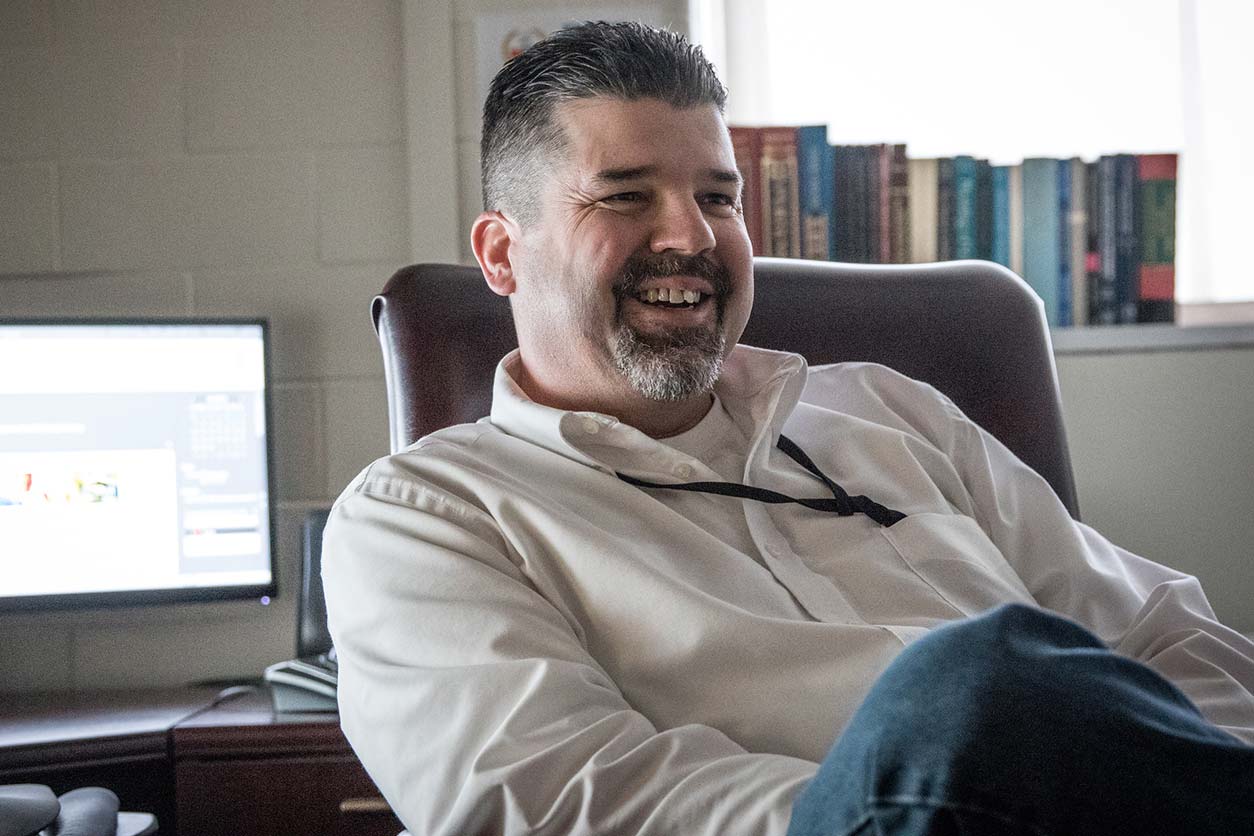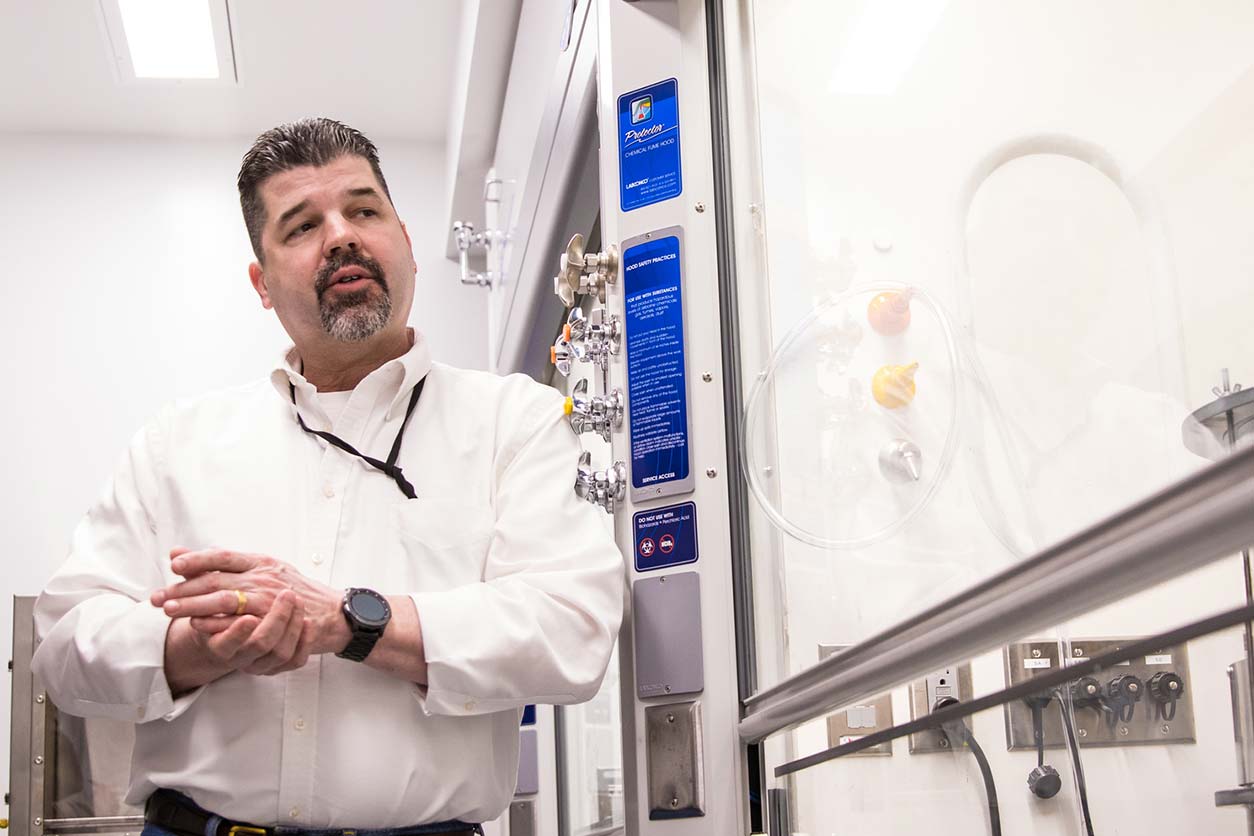
When I talk with people about environmental health sciences research, I often point out that our field should strive to move beyond studying the health effects of just one chemical at a time. That is because in my view, to better understand how real-world environmental scenarios influence health outcomes, we must study as much of the totality of our everyday exposures as possible. After all, on a given day, we are exposed to not just one substance but rather many environmental agents that may interact in potentially harmful ways. Fortunately, NIEHS scientists and grant recipients are working to expand knowledge about these complex exposures.
One such researcher is Timothy Nurkiewicz, Ph.D., from West Virginia University (WVU). He is a longtime institute grantee who, among other scientific achievements, has developed exposure chambers that can simulate complex mixtures, including one with major public health implications: burn pits. Such pits are military sites involving combustion of trash, and they have been used in places such as Iraq and Afghanistan, among other locations. Servicemembers working near burn pits were exposed to combustion of items ranging from plastic and Styrofoam to wood and paint. Unfortunately, there has been limited research to assess exactly how those exposures influence health because of the difficulty of simulating them in lab settings.
Recently, I sat down with Dr. Nurkiewicz, who chairs WVU’s Department of Physiology, Pharmacology, and Toxicology, to learn more about his efforts to better understand complex mixtures as well as his work to study burn pits using rodent models and cutting-edge exposure chambers. We also discussed potential reproductive issues associated with exposure to mixtures, why pollution size is important, and what sparked his interest in science in the first place.
Chemical mixtures’ unique dynamics
Rick Woychik: Why is it important to study how chemical mixtures affect health?
Tim Nurkiewicz: Many real-world exposure scenarios involve mixtures, and in each mixture, there is a unique dynamic that occurs between the components that can affect how they interact with human biology. A good example is how the exchange between gases and particles can cause toxicants to get into places in the body they otherwise might not if we were to study them using a single exposure model. Further complicating matters is climate change, which can influence the dynamics and chemistry of a given mixture. That is something that has not been properly addressed in past decades, where the focus was often on looking at a single toxicant.

Our team has started doing climate change experiments involving complex mixtures. We have a special exposure chamber whereby we can ramp up the temperature of a mixture to over 100°F. So far, we know that increased heat changes the aerosol profoundly. These dynamics potentially have an even more profound impact on human biology because in our rodent models, we see that the physiology of breathing changes significantly. Also, increased heat has changed many of our assumptions about how toxicants are deposited in the lungs. Going forward, we are excited to dive deeper into how climate change affects mixtures and the body’s response to them.
Motivated to study burn pits
RW: Recently, I sat next to a Veteran on a flight, and he mentioned that he experienced exposure to burn pits and expressed concern about their potential health effects. In many ways, burn pits represent a classic example of a real-world complex mixture, and they are especially relevant if you are a Veteran who has served in the Middle East. Can you tell our readers about your burn pit experiments and what motivated you to work in this area?
TN: At the beginning of the COVID-19 pandemic, there was a nationwide shortage of personal protective equipment [PPE] because most institutions gave all of their PPE to hospitals where it was most needed. In West Virginia, the National Guard handled the COVID response, and they donated all of their PPE to hospitals. Our team was approached to develop a novel form of PPE that could be used by Guardsmen around the state. We developed a close working relationship with them to identify alternate materials and alternate mask designs, both disposable and reusable. As we got to know the Guardsmen, many of whom were previously deployed in their military careers, they told us harrowing stories about their exposure to burn pits. So, we started to ask ourselves whether there was a way to help them through our research.
First, we needed to create a generator that could accurately simulate exposures to burn pit emissions. That is challenging because if you have seen one burn pit exposure, you have seen exactly one burn pit exposure — in other words, they are all different due to factors such as what exactly is in the trash, where exactly the pit is located, the size of the pit, and what was used as an accelerant. So, we concluded early on that we needed a flexible system, something that could turn on a dime and allow us to assess many different kinds of burn mixtures.
We reached out to colleagues in our university’s Division of Forestry and Natural Resources who work with green space management and alternate fuels. They are highly skilled wood pellet makers, and we asked them if their pellets could be made with different kinds of trash. They said yes, and from there we were off to the races. The pellets give our research team the flexibility we need because we can change the amount, the components, the temperature, and so forth. Today, we are using pellets made out of the chief constituents identified in burn pits, including things like wood, plastic, rubber, and Styrofoam. Going forward, we will incorporate other substances and be able to adjust for temperatures in the Middle East.

Insight into wildfire exposures
RW: It sounds like your research approach can be applied to other kinds of complex mixtures. Are you able to reproduce some of the air pollution that is generated as a consequence of climate-related events such as wildfires?
TN: Absolutely, and we are already doing that. For example, if someone is interested in studying the health consequences for firefighters, we can create an aerosol that's representative of the predominant tree and foliage type in a given area where there is a wildfire.
Also, with emissions from wildfires, chemical components can change significantly as they travel and age. So, we are developing a system that uses ultraviolet light and ozone to age the particles, mimicking real-world scenarios. We are also turning our attention to urban wildfires — which often involve novel building materials that were not used in previous years — and developing special chambers that can reproduce those exposures.
Investigating burn pits’ potential health effects
RW: Yes, the issue of the urban wildfires is so important. They are not just combusting trees and brush and things that you would find in a typical wildfire, which is dangerous enough, but rather they are also aerosolizing a wide variety of synthetic chemicals.
So, turning our attention back to burn pits, now that you have these research capabilities, what are some of your plans in terms of studying specific health effects?
TN: Much of our recent focus has been on developing and validating our burn pit generators, but we are excited to start diving into potential health effects. Our team often approaches inhalation exposures from a framework known as developmental origins of health and disease, or DOHaD. This framework aims to account for how early-life exposures — even those in preconception, on the maternal or paternal side — can affect the health of offspring later in life. We hope to incorporate that kind of analysis into our burn pit experiments going forward.
Also, we have collaborators at the Minneapolis VA Medical Center who work with a large cohort of Veterans, and these researchers have developed a full biomarker panel based on servicemembers who experienced exposure to burn pits. In our preliminary experiments, we are looking for overlap between our rodent exposures and those involving the Veterans. So far, we have found several instances of overlap, including changes in cell adhesion molecules. This is of interest to me because we have done inhalation exposure experiments for many years and then studied systemic microvascular effects, and we know that changes to these molecules can set off a series of inflammatory events that impairs the ability of arterioles to properly dilate.
Another significant influence on health outcomes may be particle size. With our chambers, we see particles that are well below PM 2.5, some even in the 100-200 nanometer range. That can affect how and where the particles end up in the body. Also, to reflect real-world burns, our generators cycle between full burns and smolder burns, and the emissions that result are often quite different. When we are burning hot, we tend to see a drop in the aerosol size, whereas the opposite occurs with our smolders. These will be important factors in our health effects studies.
Translating findings to human contexts
RW: I’m glad that you brought up the topic of nanoparticles, an area in which you have conducted extensive studies throughout the years. At WVU, you direct the Center for Inhalation Toxicology and lead an NIEHS-funded training program that brings in early career scientists from a variety of backgrounds, and I understand that nanomaterials have been a major focus. Can you talk about some of your work in this area?
TN: Sure. We have done nano-titanium dioxide inhalation exposures, carbon black exposures, and then mixtures of both carbon black and ozone. Some colleagues are interested in effects on pulmonary function, and I'm interested in microvascular function in part because I’m a microvascular physiologist by training. Some of my other colleagues are interested in reproductive outcomes and transgenerational effects. These are just some of the specific topics related to nanomaterials that we have sought to explore.
In all of these nanomaterial exposures, we try to keep the human exposure aspect front and center. For example, with titanium dioxide, it is made from ore, so there is an occupational exposure involved, and it is found in a variety of products such as air filters and water filters, so there is a consumer element at play, too. This is important because our experimental study design will be determined by whether the scientific question we are asking involves environmental, occupational, or domestic exposures. But the key is that we always keep the human element top of mind because we want our rodent models to translate to humans in a way that will advance our understanding of how these complex exposures influence their health.
(Rick Woychik, Ph.D., directs NIEHS and the National Toxicology Program.)









